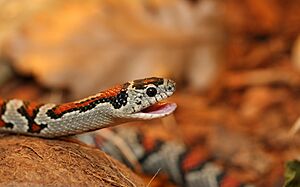Mexican kingsnake facts for kids
Quick facts for kids Mexican kingsnake |
|
|---|---|
 |
|
| Lampropeltis mexicana greeri | |
| Conservation status | |
| Scientific classification | |
| Genus: |
Lampropeltis
|
| Species: |
mexicana
|
The Lampropeltis mexicana, also known as the Mexican kingsnake, is a special type of snake. It belongs to a group called colubrid snakes. This snake is found only in Mexico, which means it is endemic there.
Contents
What Does the Mexican Kingsnake Look Like?
The Mexican kingsnake has smooth skin and a slender body. Its body is somewhat rounded, like a cylinder, but a bit flatter on its belly side. It has a wide head, large eyes, and a long tail.
Adult Mexican kingsnakes can grow to be quite long. They usually measure about 140 to 200 centimeters (about 4.5 to 6.5 feet) in length.
This snake has beautiful patterns. It has wide, red, saddle-shaped markings on its back. These red markings are outlined in black. Between the red saddles, there are bands of cream, brown, or pinkish colors. The order of these colors always stays the same. However, the exact size and shade of the color bands can be different from one snake to another.
The main type of Mexican kingsnake has special red markings and detailed patterns on its head. Interestingly, male snakes are often a bit brighter in color than females. This difference in color between males and females is called sexual dichromatism.
Where Does the Mexican Kingsnake Live?
The Mexican kingsnake lives only in the northeastern part of Mexico. The main type of this snake is found in the state of San Luis Potosí.
These snakes like to live in rocky areas. You can find them on hillsides, in valleys, and in deserts within mountains. They also live in woodlands, oak forests, and grassy areas. They can be found at high elevations, from about 1,300 to 2,400 meters (about 4,265 to 7,874 feet) above sea level.
How Does the Mexican Kingsnake Behave?
The Mexican kingsnake is a very shy and secretive animal. It is a nocturnal species, which means it is active mostly at night. During the day, it hides under rocks and fallen trees. This is why people rarely see them.
These snakes are predators. They eat other reptiles, small mammals, and amphibians. Their favorite food, however, seems to be lizards that are active during the day.
When it's time to reproduce, the Mexican kingsnake is oviparous. This means the female snake lays eggs. A female usually lays a clutch of three to five eggs at a time.
Is the Mexican Kingsnake Protected?
The IUCN (International Union for Conservation of Nature) has listed the Mexican kingsnake as a species of "Least Concern". This is good news! It means that the snake has a wide range where it lives. Also, its population is thought to be large and stable.
Sometimes, people might mistake the Mexican kingsnake for a venomous coral snake. Because of this, some people might kill them by mistake. However, the Mexican kingsnake is not venomous and is harmless to humans. Other than this, the snake does not face many big threats. Part of the area where it lives is also protected within the Santa Rosa protected area.


